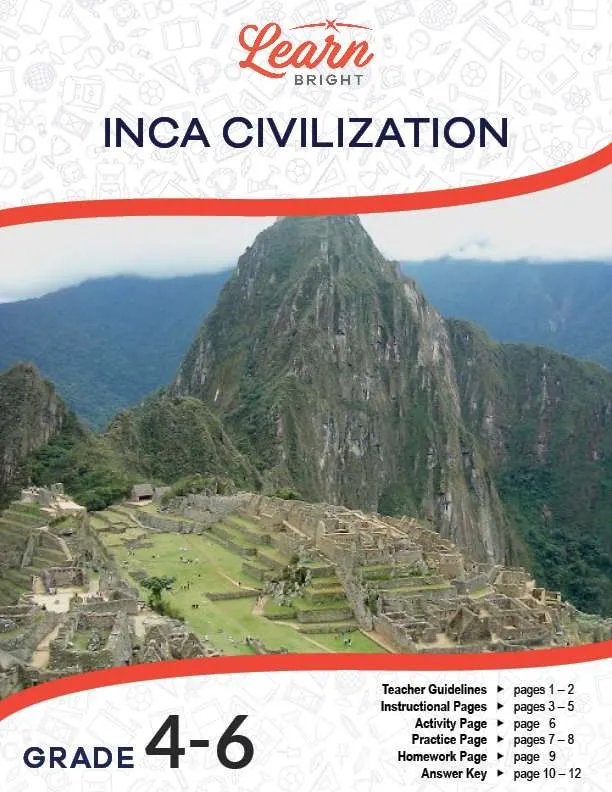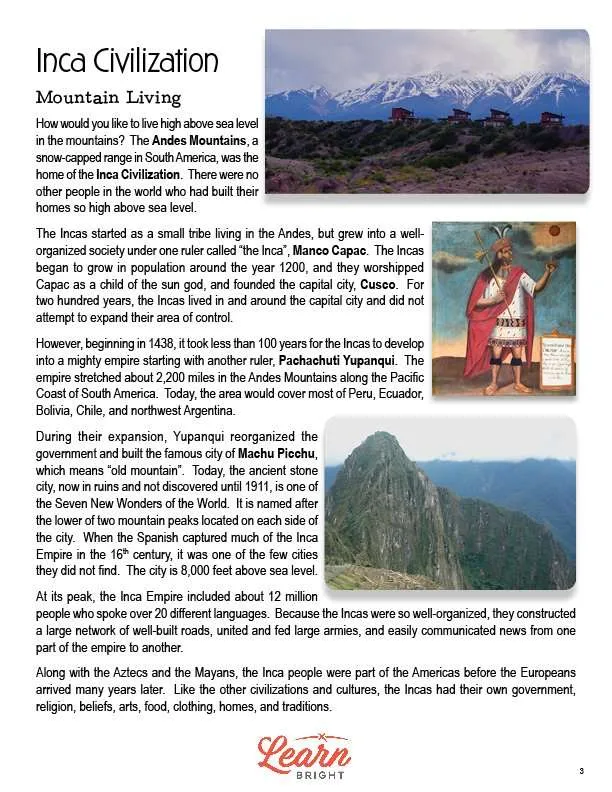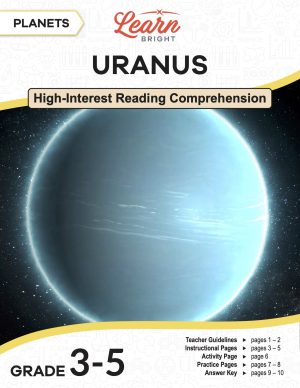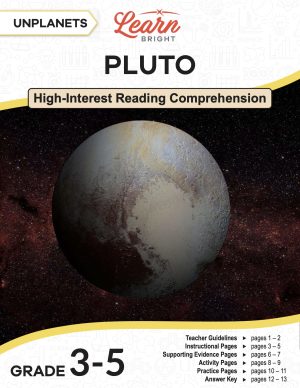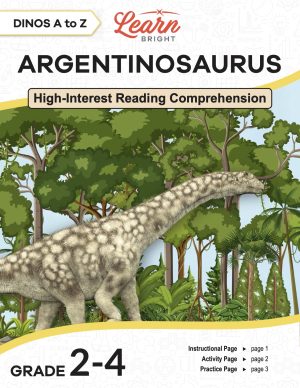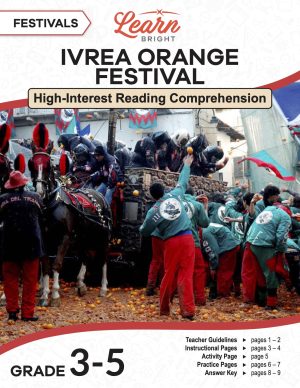Description
What our Inca Civilization lesson plan includes
Lesson Objectives and Overview: Inca Civilization lesson plan introduces students to the Inca Civilization and the events during its short time-period in history. Many students may know very little about the Inca, though it was one of the most advanced civilizations in history along with the Aztecs and Maya. At the end of the lesson, students will be able to describe, identify and list characteristics of the Inca Civilization. This lesson is for students in 4th grade, 5th grade, and 6th grade.
Classroom Procedure
Every lesson plan provides you with a classroom procedure page that outlines a step-by-step guide to follow. You do not have to follow the guide exactly. The guide helps you organize the lesson and details when to hand out worksheets. It also lists information in the orange box that you might find useful. You will find the lesson objectives, state standards, and number of class sessions the lesson should take to complete in this area. In addition, it describes the supplies you will need as well as what and how you need to prepare beforehand. To prepare for this lesson ahead of time, you can find a map for the lesson opening, pair students for the activity, and copy the handouts.
Options for Lesson
Included with this lesson is an “Options for Lesson” section that lists a number of suggestions for activities to add to the lesson or substitutions for the ones already in the lesson. One optional addition to the lesson activity is to add additional questions. For an additional activity, you could have students create models of Incan homes, using the internet to find additional details about the homes. You can also have students research their hairstyles and clothing and model those styles on Inca Day. Another option is to invite a person from the community who is a descendent of or knows about the Incas to speak to your class. You can also use the practice page as a quiz. You could plan an Ancient Civilization Week where your class studies the Mayans, Incas, and Aztecs. Finally, you could have your students research the arts and crafts of the Incas and duplicate their methods.
Teacher Notes
The teacher notes page includes a paragraph with additional guidelines and things to think about as you begin to plan your lesson. This page also includes lines that you can use to add your own notes as you’re preparing for this lesson.
INCA CIVILIZATION LESSON PLAN CONTENT PAGES
Mountain Living
The Inca Civilization lesson plan includes three content pages. The ancient Inca Civilization built their civilization in the Andes Mountains, located in South America. At this time, no other civilization had built their homes that far above sea level.
The Incas began as a small tribe in the Andes mountains. However, under the ruler Manco Capac, who they called “the Inca,” their civilization grew into a well-organized society. Their population started to grow around 1200. They believed that Capac was the child of the sun god and worshipped him, founding the capital city of Cusco. The Incas lived in this city for about 200 years before they started to expand their territory.
Starting in 1438 and over the next 100 years, the Incas developed their society into a huge empire, beginning under the rule of a man named Pachachuti Yupanqui. This empire spanned 2,200 miles in the Andes Mountains on the Pacific Coast of South America. This area would cover most of modern-day Peru, Ecuador, Bolivia, Chile, and northwest Argentina.
While they expanded, Yupanqui reconfigured the government and built the city Machu Picchu, meaning “old mountain” and named after one of the two mountain peaks on either side of the city. We didn’t even discover the ruins of this city until 1911, but it is now one of the Seven Wonders of the World. In the 16th century, when the Spanish captured most of the Inca Empire, they didn’t find Machu Picchu! It’s about 8,000 feet about sea level.
The Inca Empire, at its peak, had about 12 million people who spoke more than 20 different languages. The Incas organized their society well and had good roads, large armies, and a good system for communicating news across the empire.
The Incas, like the Aztecs and the Mayans, lived in the Americas long before the Europeans arrived. They had their own government, religion, beliefs, arts, food, clothing, homes, and traditions.
Daily Life for an Incan
Everyone in the Inca Empire held membership in an ayllu, or a group of families that worked together on a specific piece of land. Today, this would be like if your family worked together with your neighbors and shared belongings. The Incas belonged to their ayllu for life and could not move away.
Both peasants and nobles lived in ayllus. Peasants were lower class workers, like farmers, soldiers, or builders. They paid taxes and could not own land. Nobles usually worked in the government, could own their own land, and did not pay taxes.
During this time, women worked at home all day cooking, making clothes, and taking care of their children. The children of wealthy families attended school. Girls usually married by the time they were 12 years old. Peasant children often learned a craft or trade and used it to make a living. Adults mostly left their children alone during the day. They also did not usually hug or coddle them. Mothers usually fed and cleaned their children and then left them alone.
The Incas had a similar diet to the Mayans and Aztecs, with their exact foods based on their location. They ate corn, squash, beans, tomatoes, peppers, fish, turkey, and duck. Most people ate well. If they became too old to work for their food, the government fed them.
Clothing, Gold, and More
Nobles and peasants wore similar clothing, though richer people wore better quality clothing. Men wore long sleeveless shirts or tunics while women wore long dresses. They also wore capes or ponchos to stay warm during the winter. Their hairstyles indicated their social status and ayllu.
Gold was important in the Inca Empire and they used it to make ritual objects, trinkets, and jewelry. They sometimes combined it with silver and copper as well. Gold jewelry indicated wealth and power, because they believed that the sun god, Inti, sweat gold. They also believed that the moon godddess Mama-Quilla, Inti’s wife, cried silver.
The Inca people were religious and practiced different rituals with sacred buildings and temples for their gods. The sun god Inti was their main god. They thought that they needed to keep their gods happy, so they held festivals with food, music, dancing, and human sacrifices throughout the year. They mummified their dead, believing that they would watch over the living.
The Incas made their homes out of stones fitted together, without concrete or mortar. Most of the buildings were single story with thatched roofs. Laborers moved stones around the build sites using grass ropes and levers. The buildings could withstand most earthquakes because of how the builders constructed them.
The End of an Empire
The empire came to an end in 1532, about 300 years after it started. The Spanish conqueror Francisco Pizarro and his army invaded with a smaller army but better steel weapons and armor. They captured Atahualpa, the Inca emperor. He offered them a ransom of 24 tons of gold and silver in exchange for his release. They took the ransom but executed the emperor anyway. They took over and destroyed the Inca empire.
We can learn a lot about the Inca civilization. It was a short-lived but very important civilization, one of many ancient civilizations that we can study today.
Key Terms
Here is a list of the vocabulary words students will learn in this lesson plan:
- Andes Mountains: A snow-capped mountain range in South America, home to the Inca Civilization
- Manco Capac: The first ruler of the Inca
- Cusco: The capital city of the Inca Civilization
- Pachachuti Yupanqui: The Incan ruler beginning in 1438
- Machu Picchu: A famous Inca city whose name means “old mountain”
- Ayllu: A group of families who worked together on a portion of land
- Peasants: Lower class people who were hard workers
- Nobles: People who mostly worked in government, could own land, and did not pay taxes
- Inti: The sun god
- Mama-Quilla: The moon goddess
- Francisco Pizarro: A Spanish conqueror who destroyed the Inca Civilization
- Atahualpa: The last Inca emperor; he tried to ransom gold and silver for his release
INCA CIVILIZATION LESSON PLAN WORKSHEETS
The Inca Civilization lesson plan includes three worksheets: an activity worksheet, a practice worksheet, and a homework assignment. You can refer to the guide on the classroom procedure page to determine when to hand out each worksheet.
COMPARISON ACTIVITY WORKSHEET
Students will work with a partner to complete the activity. Each pair will imagine that they are archaeologists 500 years in the future and the United States does not exist any more. They will pretend that they have discovered artifacts and ruins of the U.S. and will answer five questions comparing the Inca Civilization to the United States.
Students can work either alone or in larger groups for this activity if you’d prefer.
BEST ANSWER PRACTICE WORKSHEET
The practice worksheet asks students to circle the best answer for 15 questions about the lesson material.
INCA CIVILIZATION HOMEWORK ASSIGNMENT
For the homework assignment, students will complete two short exercises. For the first, they will match the description to the correct number. And for the second, they will read statements and tell whether they are true or false.
Worksheet Answer Keys
This lesson plan includes answer keys for the practice worksheet and the homework assignment. If you choose to administer the lesson pages to your students via PDF, you will need to save a new file that omits these pages. Otherwise, you can simply print out the applicable pages and keep these as reference for yourself when grading assignments.

